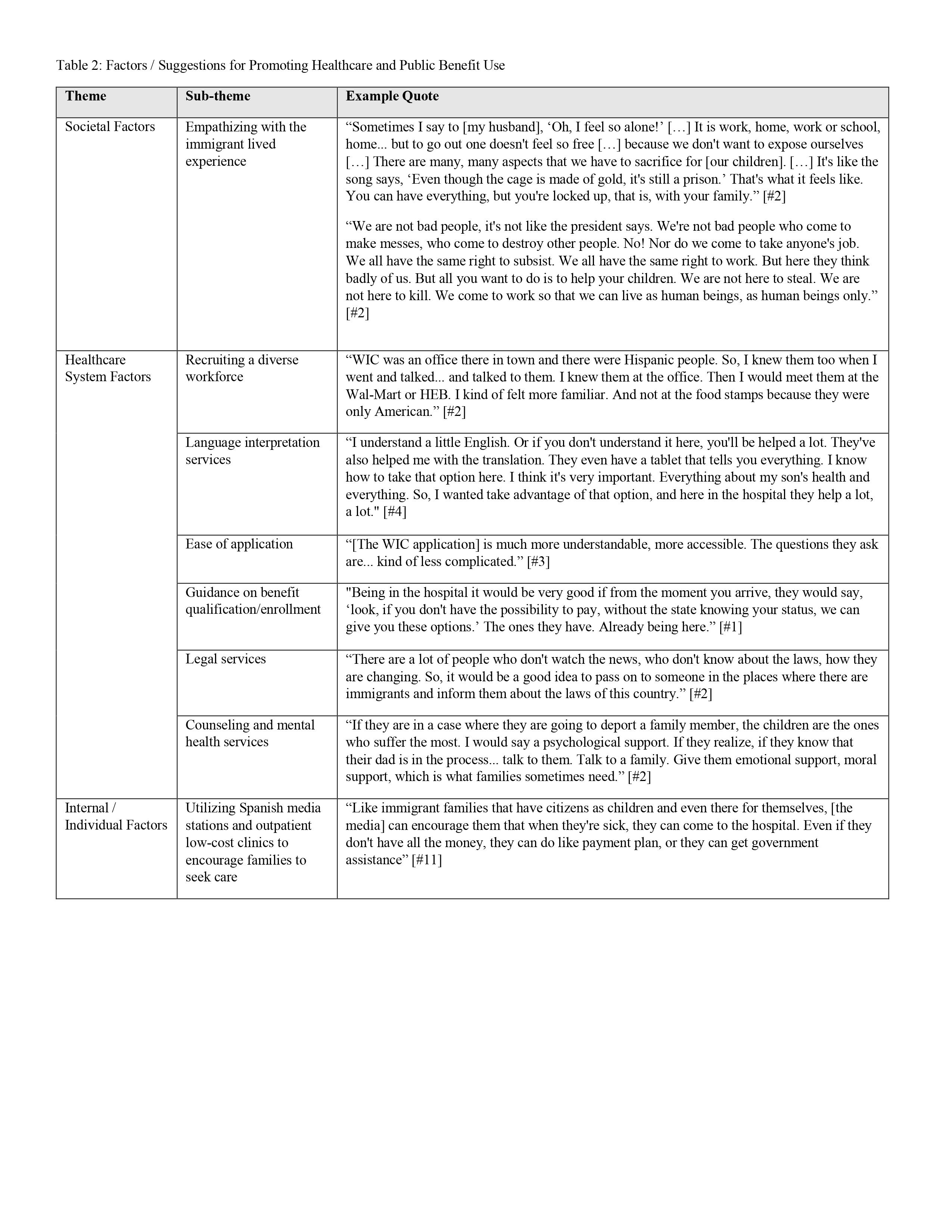Back
Health Equity/Social Determinants of Health
Category: Abstract Submission
Health Equity/Social Determinants of Health V
167 - “Even Though the Cage is Made of Gold, It’s Still a Prison”: A Qualitative Study of Immigrant Caregiver Barriers in Access to Care and Public Benefit Support in the United States
Monday, April 25, 2022
3:30 PM – 6:00 PM US MT
Poster Number: 167
Publication Number: 167.412
Publication Number: 167.412
Marina Masciale, Baylor College of Medicine, Houston, TX, United States; Heather Haq, Baylor College of Medicine, Houston, TX, United States; Mariana Carretero Murillo, Texas Children's Hospital, Houston, TX, United States; Karen D. Gibbs, Texas Children's Hospital, Houston, TX, United States; Rathi Asaithambi, Baylor College of Medicine, Houston, TX, United States; Karla Fredricks, Baylor College of Medicine/Texas Children's Hospital, Houston, TX, United States; Gabriela Espinoza-Candelaria, UPMC Childrens Hospital of Pittsburgh, Pittsburgh, PA, United States; Michelle Lopez, Baylor College of Medicine, Houston, TX, United States; Jose Dominguez, Cambridge Health Alliance, Cambridge, MA, United States; Maria A. Jaramillo, Baylor College of Medicine, Houston, TX, United States; Claire E. Bocchini, Baylor College of Medicine and Texas Childrens Hospital, Houston, TX, United States

Heather A. Haq, MD, MHS (she/her/hers)
Assistant Professor
Baylor College of Medicine
Houston, Texas, United States
Presenting Author(s)
Background: Children in immigrant families (CIF) comprise ~25% of United States (US) children and live in families with high levels of poverty and food insecurity. Studies support a recent decline in public benefit enrollment among CIF.
Objective: We aimed to explore immigrant caregiver perspectives on barriers to child healthcare and public benefit use, as well as suggested healthcare interventions to mitigate these barriers.
Design/Methods: Using a general qualitative descriptive design, we developed a semi-structured interview guide using an iterative process informed by literature and content expertise. We performed purposeful sampling of immigrant caregivers of hospitalized children in March 2020. Trained facilitators conducted interviews in English or Spanish. Interviews were recorded, transcribed, and translated to English. Three authors applied codes inductively to transcripts using Dedoose and identified themes using a thematic analysis approach.
Results: Twelve caregiver interviews revealed barriers to healthcare and public benefit use and suggestions for their mitigation. Societal barriers included racism and discrimination among government officials and healthcare providers. Healthcare system barriers included provider distrust, language barriers, cost, complexity of resource application, and lack of guidance on available benefits. Individual factors included immigration-related fear and alternative preferences. Barriers to benefit use can be found in Table 1. Suggested interventions to mitigate barriers in resource use included empathizing with the immigrant lived experience, recruiting a diverse workforce, utilizing language interpretation services, hospital guidance on benefit eligibility/enrollment, partnership with legal services, partnership with mental health services, and utilizing Spanish media stations (such as Univisión or Telemundo) to provide outreach/education to immigrant families. Suggestions for barrier interventions can be found in Table 2. Conclusion(s): Immigrant families face several barriers to healthcare and public benefit use. Hospital partnership with trusted community organizations to connect families with resources may mitigate these barriers.
Table 1.jpg) Barriers to Public Benefit and Healthcare Use
Barriers to Public Benefit and Healthcare Use
Table 2 Factors/Suggestions for Promoting Healthcare and Public Benefit Use
Factors/Suggestions for Promoting Healthcare and Public Benefit Use
Objective: We aimed to explore immigrant caregiver perspectives on barriers to child healthcare and public benefit use, as well as suggested healthcare interventions to mitigate these barriers.
Design/Methods: Using a general qualitative descriptive design, we developed a semi-structured interview guide using an iterative process informed by literature and content expertise. We performed purposeful sampling of immigrant caregivers of hospitalized children in March 2020. Trained facilitators conducted interviews in English or Spanish. Interviews were recorded, transcribed, and translated to English. Three authors applied codes inductively to transcripts using Dedoose and identified themes using a thematic analysis approach.
Results: Twelve caregiver interviews revealed barriers to healthcare and public benefit use and suggestions for their mitigation. Societal barriers included racism and discrimination among government officials and healthcare providers. Healthcare system barriers included provider distrust, language barriers, cost, complexity of resource application, and lack of guidance on available benefits. Individual factors included immigration-related fear and alternative preferences. Barriers to benefit use can be found in Table 1. Suggested interventions to mitigate barriers in resource use included empathizing with the immigrant lived experience, recruiting a diverse workforce, utilizing language interpretation services, hospital guidance on benefit eligibility/enrollment, partnership with legal services, partnership with mental health services, and utilizing Spanish media stations (such as Univisión or Telemundo) to provide outreach/education to immigrant families. Suggestions for barrier interventions can be found in Table 2. Conclusion(s): Immigrant families face several barriers to healthcare and public benefit use. Hospital partnership with trusted community organizations to connect families with resources may mitigate these barriers.
Table 1
.jpg) Barriers to Public Benefit and Healthcare Use
Barriers to Public Benefit and Healthcare UseTable 2
 Factors/Suggestions for Promoting Healthcare and Public Benefit Use
Factors/Suggestions for Promoting Healthcare and Public Benefit Use